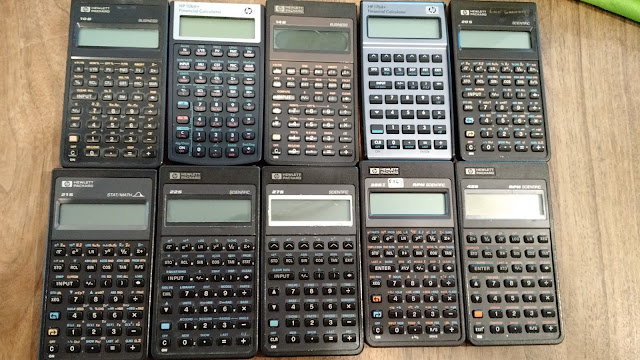Retro Review: HP 22S
 |
| HP 22S |
 |
| Pioneers: 10B, 10bII+ (updated), 14B, 17bII+ (updated), 20S, 21S, 22S, 27S, 32SII, 42S |
Essentials
Company: Hewlett Packard
Years: 1988 - 1991
Type: Scientific, Formula Programming
Memory: 371
Operating
System: Algebraic
Memory
Registers: 26 (A-Z)
Number of Built
In Equations: 16
Batteries: 3 LR44, 3 A76, 3 357
Features
The HP 22S is
an algebraic calculator that shares the similar style with the HP 20S, 21S,
32S, and 42S. The top row of keys ([ √x
], [ e^x ], [ LN ], [ y^x ], [ 1/x ], [ Σ+ ]) act not only as function keys but
soft menu keys.
The standard
variety of functions are present:
* Trigonometric,
hyperbolic, exponential, and logarithmic functions
*
Conversions: kg/lb, °C/°F, cm/in,
ltr/gal, H/HMS, DEG/RAD
* Probability: nCr, nPr, n!
(the factorial function only accepts integer)
* Integer part,
fractional part, absolute value, round to fix setting
*
Statistics: 1 Variable and Linear
Regression (y = mx + b)
* Storage
arithmetic
* Base
conversions: Binary, Decimal, Octal, Hexadecimal. Decimal mode is floating decimal mode.
* This is
really cool: the rectangular (x-COORD,
y-COORD) and polar (RADIUS, ANGLE) conversions get their own keys (well,
shifted functions of [ 1 ], [ 2 ], [ 3 ], and [ - ], respectively)
* Percent
Change: old [INPUT] new [(shift)] [1/x]
(%CHG) (nPr and nCr work the same way)
Overall the
keys are really easy to work with and the calculator is a pleasure to use. I like the crisp display. Plus, if blue is
your favorite color like me, the light blue font against the dark background is
a plus.
There are two
manuals with the HP 22S: the User
Manual, and the excellent Science Student Applications for the HP 22S.
Equations
You can either
use one of the 14 built-in equations (listed below) or create your own. While you are creating your own, you can use
either the [STO] or [RCL] keys to call up a letter. All variables are one letter and global.
Equations that are longer than the 12 character display can be scrolled by the
[ √x ] and [ Σ+ ] keys.
Equations can
be evaluated (evaluate the right side of the equation) or solved (a menu will
show the variables to be solved for).
Equations are solved in a reasonably amount of time.
The 16 built in
equations, which are displayed by the equations themselves (no titles):
(Source: HP 22S
manual)
Title
|
Equation
|
Length of a
Line/Vector
|
R=SQRT(X^2+Y^2+Z^2)
|
Roots of a
Quadratic Equation
|
X=(-B+J*SQRT(B^2-4*A*C))÷2÷A
Real roots
only, J = -1 or 1
|
Equation of
Motion (Position)
|
X=S+V*T+.5*A*T^2
X = position,
V = velocity, A = acceleration
|
Equation of
Motion (Final Velocity)
|
F=V+A*T
|
Kinetic
Energy
|
E=.5*M*V^2
|
Force Between
Two Objects (Physics or Electric Force)
|
F=K*A*B÷R^2
K =
6.67408E-11 m^3 kg^-1 s^-2 (gravitational force)
K =
1.602176621E-19 J (electron charge)
|
Joule’s Law
|
P=I^2*R
|
Ideal Gas Law
|
P*V=N*R*T
|
Gibb’s Free
Energy
|
G=H-T*S
|
Pressure of a
Fluid
|
P=I+D*G*H
G = 9.80665
m/s^2
|
Radioactive
Decay
|
-K*T=LN(N÷I)
|
Thin Lens
Equation
|
O*F+I*F=O*I
|
Diffraction
|
A=ASIN(M*L÷D)
|
Exponential
Growth and Decay
|
Y=F+(I-F)*EXP(K*T)
|
Root Mean
Square
|
R=SQRT(Σx^2÷n)
Σx^2 and n
come from statistical data
|
Time Value of
Money
(End of
Period payments/periods assumed)
|
(P*100÷I-F)*(1+I÷100)^-N-P*100÷I=B
N = number of
payments/periods
B = present
value
I = periodic
interest rate
P = payment
F = future
value
|
Final Verdict
The HP 22S is a
great calculator to own. I love the
rectangular/polar conversion set up. The
display is great.
My only criticism
is that I wish the 22S had more memory.
371 bytes can store a handful equations, but data points that are used
in the statistical calculations and storing values in the variables A-Z eat up
the memory as well.
4 out of 5
stars.
Eddie
This blog is
property of Edward Shore, 2017
Coming soon (tentative): a review of a favorite Texas Instruments calculator, TI-68.
Coming soon (tentative): a review of a favorite Texas Instruments calculator, TI-68.